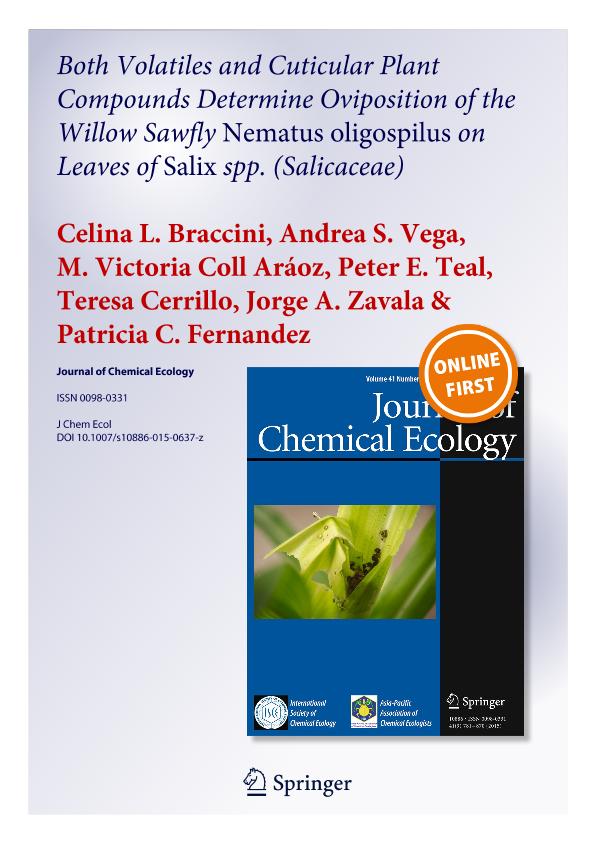Mostrar el registro sencillo del ítem
dc.contributor.author
Braccini, Celina L.
dc.contributor.author
Vega, Andrea Susana

dc.contributor.author
Coll Araoz, Maria Victoria

dc.contributor.author
Teal, Peter E.
dc.contributor.author
Cerrillo, Teresa

dc.contributor.author
Zavala, Jorge Alberto

dc.contributor.author
Fernandez, Patricia Carina

dc.date.available
2018-04-13T22:01:35Z
dc.date.issued
2015-10
dc.identifier.citation
Braccini, Celina L.; Vega, Andrea Susana; Coll Araoz, Maria Victoria; Teal, Peter E.; Cerrillo, Teresa; et al.; Both Volatiles and Cuticular Plant Compounds Determine Oviposition of the Willow Sawfly Nematus oligospilus on Leaves of Salix spp. (Salicaceae); Springer; Journal of Chemical Ecology; 41; 11; 10-2015; 985-996
dc.identifier.issn
0098-0331
dc.identifier.uri
http://hdl.handle.net/11336/42067
dc.description.abstract
Plant volatile organic compounds play a role in selection of host plants by herbivorous insects. Once the insect reaches the plant, contact cues determine host acceptance. Although the willow sawfly Nematus oligospilus (Hymenoptera: Tenthredinidae) can differentiate among willow genotypes, no knowledge is available on the cues used by this insect to seek and accept the host plant. In this study, we recorded behavioral orientation in a Y-tube olfactometer of willow sawfly females to volatiles of the highly preferred genotype Salix nigra and the non-preferred genotype S. viminalis. The volatiles released by undamaged willows of each genotype were analyzed by coupled gas chromatography-mass spectrometry. Contact cues were evaluated first by oviposition preference bioassays after selective leaf wax removal, and then by studying the micromorphology of abaxial and adaxial leaf surfaces and their chemical composition. Willow sawfly females oriented preferentially to S. nigra volatiles, which contained more than 3 times theamount of volatiles than that collected from S. viminalis. Analysis of volatiles showed significant differences in amounts of (Z) and (E)-β-ocimene, undecane, decanal, and β-caryophyllene. The adaxial leaf surface of S. nigra was less preferred after wax removal, suggesting a role of cuticular waxes for oviposition acceptance. No differences were found among the micromorphology of leaf surfaces between preferred and non-preferred genotypes. The chemical analysis of cuticular waxes showed that the abaxial leaf surface of S. viminalis, which is completely avoided for oviposition, possessed 97 % of alkanes. The accepted leaf surfaces contained a more diverse wax profile including alcohols, acids, and esters. Thus, non-alkane wax compounds might be related to oviposition. In sum, our study suggests that several cues act in concert to provide oviposition cues for the sawfly N. oligospilus: females are attracted to volatiles from a distance, and once alighting on the plant, they seek specific chemical contact cues in order to lay eggs.
dc.format
application/pdf
dc.language.iso
eng
dc.publisher
Springer

dc.rights
info:eu-repo/semantics/openAccess
dc.rights.uri
https://creativecommons.org/licenses/by-nc-sa/2.5/ar/
dc.subject
Oviposition Cues
dc.subject
Tenthredinidae
dc.subject
Insect-Plant Interaction
dc.subject
Host Plant Location
dc.subject
Volatiles
dc.subject
Cuticular Wax
dc.subject
Olfactometer
dc.subject.classification
Otras Ciencias Biológicas

dc.subject.classification
Ciencias Biológicas

dc.subject.classification
CIENCIAS NATURALES Y EXACTAS

dc.title
Both Volatiles and Cuticular Plant Compounds Determine Oviposition of the Willow Sawfly Nematus oligospilus on Leaves of Salix spp. (Salicaceae)
dc.type
info:eu-repo/semantics/article
dc.type
info:ar-repo/semantics/artículo
dc.type
info:eu-repo/semantics/publishedVersion
dc.date.updated
2018-04-12T14:29:26Z
dc.identifier.eissn
1573-1561
dc.journal.volume
41
dc.journal.number
11
dc.journal.pagination
985-996
dc.journal.pais
Alemania

dc.journal.ciudad
Berlin
dc.description.fil
Fil: Braccini, Celina L.. Instituto Nacional de Tecnología Agropecuaria. Centro de Investigación de Recursos Naturales. Instituto de Recursos Biológicos; Argentina
dc.description.fil
Fil: Vega, Andrea Susana. Universidad de Buenos Aires. Facultad de Agronomía; Argentina. Consejo Nacional de Investigaciones Científicas y Técnicas; Argentina
dc.description.fil
Fil: Coll Araoz, Maria Victoria. Consejo Nacional de Investigaciones Científicas y Técnicas. Centro Científico Tecnológico Conicet - Tucumán. Planta Piloto de Procesos Industriales Microbiológicos; Argentina
dc.description.fil
Fil: Teal, Peter E.. United States Department of Agriculture; Estados Unidos
dc.description.fil
Fil: Cerrillo, Teresa. Instituto Nacional de Tecnología Agropecuaria. Centro Regional Buenos Aires Norte. Estación Experimental Agropecuaria Delta del Paraná; Argentina
dc.description.fil
Fil: Zavala, Jorge Alberto. Universidad de Buenos Aires. Facultad de Agronomía; Argentina. Consejo Nacional de Investigaciones Científicas y Técnicas; Argentina
dc.description.fil
Fil: Fernandez, Patricia Carina. Instituto Nacional de Tecnología Agropecuaria. Centro Regional Buenos Aires Norte. Estación Experimental Agropecuaria Delta del Paraná; Argentina. Consejo Nacional de Investigaciones Científicas y Técnicas; Argentina
dc.journal.title
Journal of Chemical Ecology

dc.relation.alternativeid
info:eu-repo/semantics/altIdentifier/doi/http://dx.doi.org/10.1007/s10886-015-0637-z
dc.relation.alternativeid
info:eu-repo/semantics/altIdentifier/url/https://link.springer.com/article/10.1007%2Fs10886-015-0637-z
Archivos asociados
